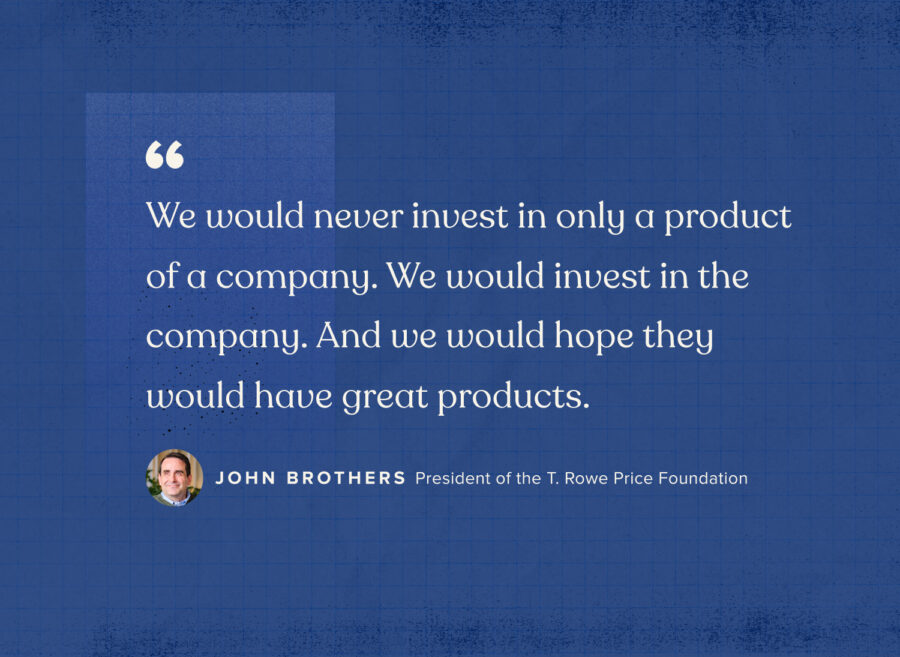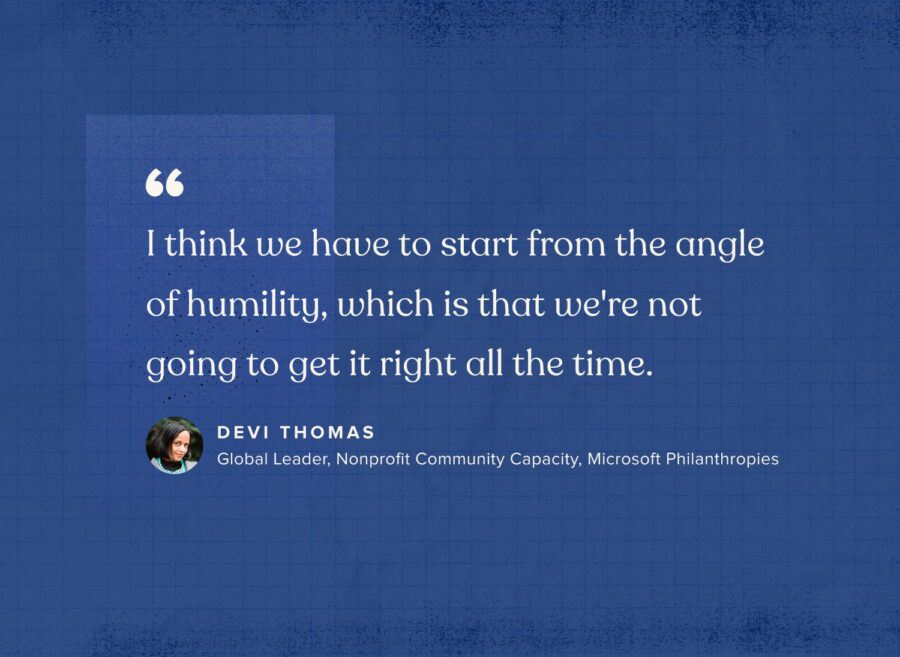When you invest in Coca Cola, you’re not investing in Diet Coke. You’re investing in the Coca Cola brand.
The same is true for investments in corporate philanthropy.
At least, that’s how John Brothers sees it. Brothers, president of the T. Rowe Price Foundation and a trailblazer in the trust-based social good space, knows that you trust a nonprofit to do their best work by granting funding—not by investing in specific programs, events, or a single year of work.
He also knows that it’s easier to get executive buy-in for CSR programs and grantmaking when you map philanthropic best practices to familiar corporate concepts.
While you can’t impose business concepts fully on a 1:1 scale to the social impact sector, you can draw parallels to help profit-focused executives understand the benefits and best practices of investing in social good.
Let’s explore how you can leverage well-known business concepts to get internal buy-in for corporate philanthropy—especially for trendy approaches like trust-based philanthropy and unrestricted funding.

1. Long-term investment is key to growth and innovation
Companies don’t invest in R&D and expect growth to occur on a set timeline. Instead, they invest in outcomes, however long they take, to foster innovation in its most authentic form.
Similarly, in corporate philanthropy, you can’t fund short-term projects and expect to see any sort of transformative impact. As Brothers notes, companies don’t invest in one-year increments; they look for the long term.
He draws a parallel with the corporate world using the Coca-Cola metaphor, “We would never invest in only a product of a company. We would invest in the company. And we would hope they would have great products.”

One idea trust-based philanthropy champions is the idea of extended, unrestricted funds for nonprofit grantees—funds that nonprofits can use as needed, without the limitations or specific directives often attached to traditional grants.
Unrestricted funding recognizes that nonprofits are often in the best position to understand the immediate, evolving needs of the communities they serve better than corporate donors do. This funding model allows nonprofits to allocate resources where they’re most needed, including infrastructure and operational costs often overlooked by restricted grants.
For example, a nonprofit’s most pressing needs might consist of hiring janitorial staff to keep facilities clean. If they receive funding that’s restricted to buying food for the hungry, those hungry people are now eating in a dirty facility, which ultimately doesn’t serve the community’s needs.
Unrestricted funding demonstrates trust, grants security, and helps nonprofits maintain a solid foundation from which to continue carrying out their mission. It acknowledges that nonprofits know best not only the needs of their communities, but also what they require to operate effectively and meet those needs. This approach allows nonprofits to be agile and responsive, keeping the ball rolling towards making the most significant impact possible.
Devi Thomas from Microsoft Philanthropies explains that nonprofits working with limited resources have few options to “fail fast” and innovate in a corporate way. But with corporate support, especially in the form of unrestricted funding, nonprofits have room to experiment, adapt, and embrace new technologies and strategies, much like the private sector.
“When nonprofits have fewer options, it’s because they’re not willing to experiment in the same way that other sectors might be willing to experiment. And this is where, again, we have that opportunity to learn from each other, collaborate, and co-create, because we can take on some of the risks associated with making mistakes,” says Thomas. “And that is not something that someone who serves communities in life-improving in life-changing ways is necessarily going to be able to do.”
View funding as a long-term investment instead of a one-time, or year-by-year allocation of resources. It’s about giving mission-driven organizations the space and stability to adapt, experiment, and evolve, just like for-profit businesses do.

2. Impact is sometimes qualitative
In content marketing, you don’t nickel-and-dime the impact of every article published. Instead, you focus more broadly, looking at the total impact on your brand from your entire body of work. And results are sometimes anecdotal—that one whitepaper resonated especially true for a big client, or your podcast bringing on guests with valuable insights—rather than quantifiable.
Similarly, philanthropy is best measured not in dollars donated or hours volunteered, but in terms of the total social good done—a measurement that doesn’t always have a quantifiable ROI.
That’s not to say that there is no ROI, but instead that it’s impossible to measure the true value of transformative, sustainable social impact in numbers. Instead, the ROI of social impact is often qualitative—measured in lives changed, stories told, and people helped.
However, corporate funders and donors often place pressure on nonprofits to demonstrate the value of their investment.
Vu Le, former executive director of Seattle nonprofit RVC (and veritable nonprofit celebrity), raises a critical point about the unrealistic expectations often placed on nonprofits to prove impact: “Most funders will think it’s perfectly fine, even best-practice, to ask a nonprofit to parse out what their 10K or 100K specifically accomplished, and to do it on the funder’s own timeline, and not what timeline makes sense for the nonprofit’s programs and services and fiscal year. Can you imagine if for-profits are expected to do this?”
Brothers says demanding a nonprofit to show you their impact is like walking into someone’s house and asking them to weigh themselves, expecting a certain number to show on the scale. It’s simply not a fair, respectful, or even accurate method of assessment.
Instead, funders need to take a more flexible, trust-based approach to CSR reporting. While traditionally a financial metric, ROI in social impact comes down to the change achieved through philanthropic efforts.
In business investments, ROI is not just about immediate profits, but long-term value creation. One of the main benefits of CSR is strengthening your brand reputation, and that’s not something that can be measured and attributed overnight.
As Jaimie Vargas, Head of Global Social Impact at Electronic Arts, says, “The sweet spot I think where CSR and social impact can really shine, is being a function that maybe doesn’t generate,” says Vargas. “Not a cost center—it’s like a pride center.”
3. “Customers” come first
Everyone’s heard the old adage, the customer is always right. While not always true, it still holds water in the sense that businesses orient around customer needs.
In corporate philanthropy, the community you serve is your customer base. However, your relationship with community members is less transactional, and more mutually beneficial. Your community’s aspirations and feedback should shape the programs and services you and your nonprofit partners provide. Communities are more than beneficiaries with needs—they’re key stakeholders with valuable insights and agency.
Brothers criticizes the complicated, needs-based nature of grant applications, pointing out that they’re not community-centric and are time-consuming to fill out—some scaling upwards of 20-pages long.
“Communities don’t recognize themselves as needs,” Brothers says. “My advice to CSR and philanthropy professionals that are wanting to do this work well is start with your bedside manner and the how of your work. The very nature of the work after that is going to be that much better because you really spent time on how that work interacts with the community and its residents.”
In essence, put the community you serve at the heart of your CSR work. Understand that you are an outsider to any given place, and that the community understands its needs better than you do.
Additionally, don’t view nonprofits as employees. You don’t need to evaluate their performance or measure their output. In fact, there’s too much emphasis on evaluating impact, and not enough on learning, according to Brothers. It’s not corporate philanthropy’s job to dictate these parameters, he argues.
“It’s the job of communities to know what they should measure, how they should be learning, and what that learning should be doing for them each and every day,” Brothers says. “Once they know that, my job is to support them to that end—not to be a coach watching them and saying, ‘You’re not light enough. You need to do this.’”
By redistributing power and recognizing the community you serve as its own best subject matter expert, you’ll keep your philanthropic efforts equitable, respectful, and truly impactful.

4. Success depends on strong partnerships
Just as businesses often thrive through strategic partnerships, successful corporate philanthropy depends on nonprofit corporate partnerships based on mutual respect and a shared vision. These relationships transcend the traditional top-down, donor-recipient dynamic, fostering a synergy where both parties contribute, listen to each other, and gain value.
Nonprofit partnerships can be just as strategic and mutually beneficial as business deals. Brothers describes “shared value” as one of the T. Rowe Price Foundation’s core tenets, allocating corporate resources to fill community needs.
“Places like Baltimore, where we do a lot of our work in a very place-based way, struggle with infrastructure. And that’s what often companies have in abundance. We incubate and start, based on feedback from our community partners, initiatives that fill patches in the social safety net,” said Brothers.
“And so we’ve created about 20 initiatives here that ultimately we partner with, seed, sometimes run, and then hand them off to our community partners for the long term. We’re huge into what we call sharing sugar, which is basically this idea of collaborating and partnering and, from our vantage point, really using our social capital to benefit the larger community.”
Thomas, who brings over 20 years of experience in the nonprofit sector to the tech world now with Microsoft Philanthropies, speaks to the value of these partnerships from the nonprofit and corporate perspectives.
“It’s really been an opportunity to understand how can a nonprofit best leverage its resources, its scrappy kind of approach, or sometimes even its proximity to the community, to be able to partner with us in a way that really helps not just the sector, but helps us in philanthropy become better sort of advocates for those communities,” said Thomas.
Thomas says that the most effective partnerships come from recognizing what we don’t know and that we need to work together to succeed.
“I think we have to start from the angle of humility, which is that we’re not going to get it right all the time. But we also know that we cannot do it alone…Giving yourself the grace to try and to fail…and really understanding that you’re one part of a puzzle.”

Nonprofit-corporate partnerships, when built on a foundation of mutual respect, shared value, and strategic collaboration, can yield significant benefits for both parties. These partnerships allow for the pooling of resources, expertise, and perspectives, leading to innovative CSR initiatives, transformative grantmaking, and sustainable social impact that neither could achieve alone.
Pitch philanthropy as a corporate strategy
The key to getting executive support for philanthropy is to present it as a strategic investment, just like any other business venture. Highlight the mutual benefits, long-term value, and potential for innovation and brand recognition. Frame your pitch in terms that resonate with corporate leaders, using language and frameworks that make sense to a board of directors that might be more focused on the bottom line.
But be careful not to position corporate philanthropy as a profit-generator; remember that the ROI of social impact is a long-term, qualitative metric.
Once you successfully secure executive buy-in, amplify the impact of your CSR strategy with the right CSR software. Modern solutions built for the long-term, like Submittable, can help you take your CSR to the next level.